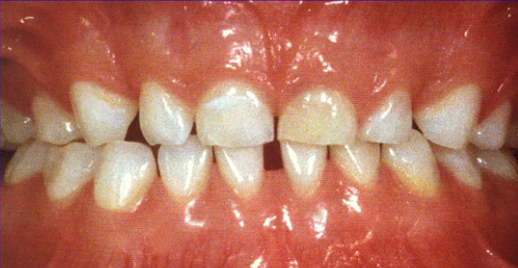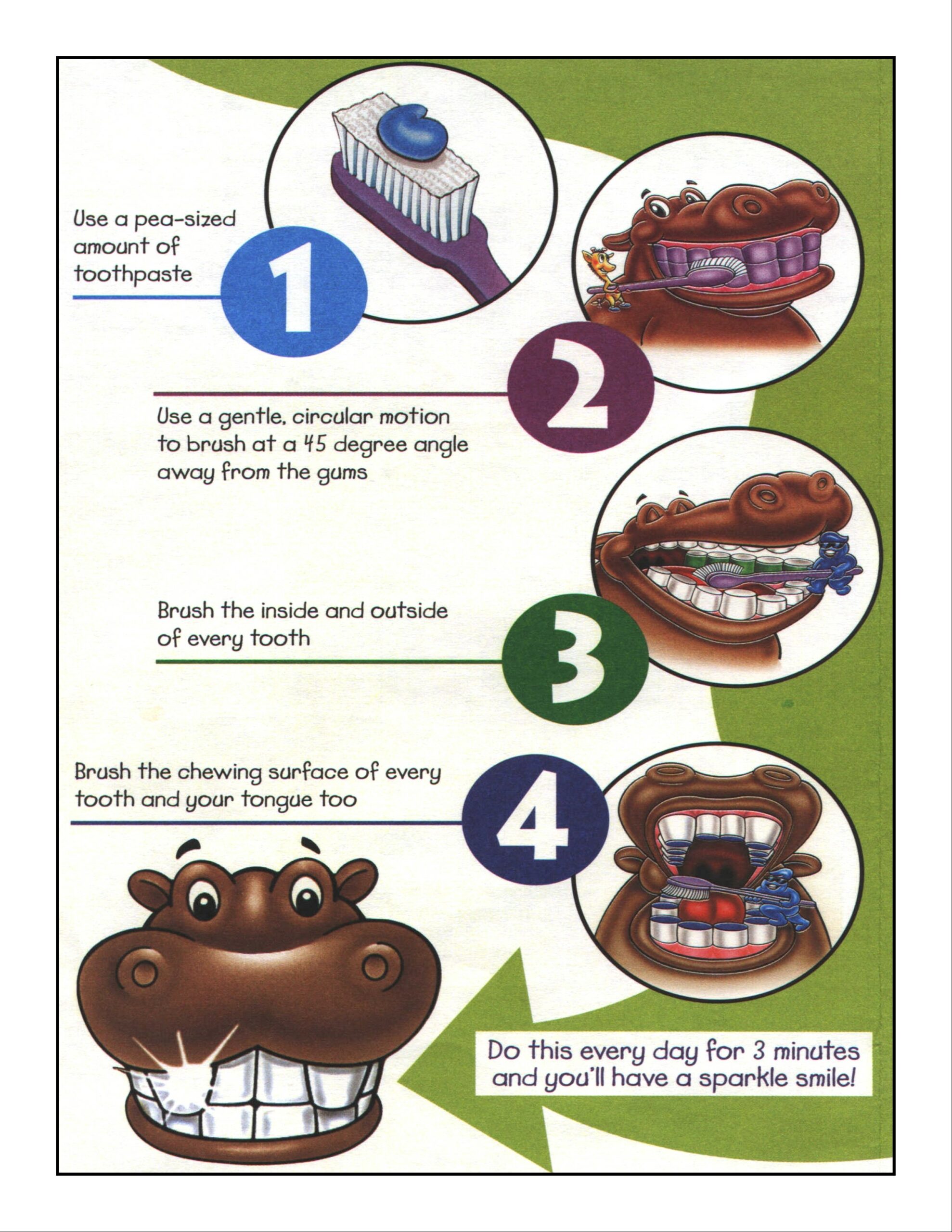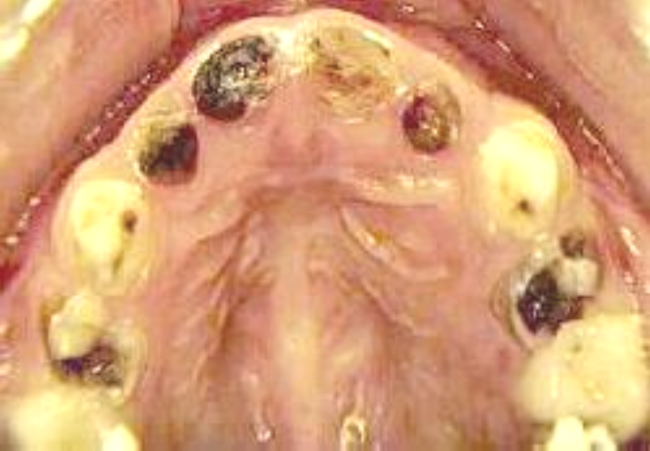PRIMARY TEETH ARE IMPORTANT!
Your child’s first set of teeth are called “primary teeth”. These teeth are more important than most people realize. Healthy primary teeth assist in children’s chewing abilities and speech development. They also act as “space-savers” in the jaw for the positioning of permanent teeth. Maintaining the health of their primary teeth may reduce the need for future orthodontic work. Most importantly, a strong, beautiful smile helps your child to develop good self-esteem.
DENTAL DECAY
The most common cause of tooth loss in children is tooth decay (cavities). Tooth decay is caused by the action of bacteria in the plaque. Plaque is a sticky, clear film that forms on our teeth every day. Plaque helps the bacteria stick to our teeth. The sugar in food and drinks reacts with bacteria to form an acid that eats away the hard outer layer (enamel). Over time, this acid will make a hole or cavity in the enamel.
The three main factors that predispose some children to developing more tooth decay than others include:
- Frequent consumption of sugars.
- Low fluoride levels. Fluoride acts with minerals in saliva to restore and harden enamel damaged by the very early stages of decay. This remineralising may help to arrest the decay and to make fully formed teeth more resistant to further damage.
- Failure to brush adequately to remove all plaque and the associated bacteria.
TIPS ON PREVENTION
Brushing and Flossing
- Brush twice per day for at least two minutes. This ensures adequate time is spent cleaning all the surfaces of each tooth (See the Hippo Diagram)
- Use only a pea–sized drop of a fluoride toothpaste (a junior or children’s toothpaste with lower fluoride content toothpaste is best)
- Use a Power Toothbrush. They clean teeth better than manual brushes. Battery–powered brushes by Oral B, Crest, or Colgate are suitable, inexpensive and widely available at drug stores. If your child prefers a manual toothbrush make sure it is a children’s size with soft bristles.
- Floss your child’s teeth. It is advisable to begin at about age three when their teeth begin to fit closer together in the back. To improve access to the back teeth and make the job easier, we suggest using a “floss pick” which is also readily available in drug stores.
- Help your child brush and floss. Children do not have the manual dexterity to use a toothbrush or floss properly until they are about seven or eight so an adult should help to ensure thorough oral care. Suggest taking turns if the child is resistant.

Fluoride
- Give your child a nightly fluoridated mouth rinse when they can understand and perform the “rinse and spit” routine (about 4 or 5 years old. This is not a mouthwash used to cover bad breath. It is a supplement to the topical fluoride treatments your child receives at the dentist’s office. However, it is not nearly as strong as the office version.
- Make sure your child receives a fluoride treatment at the time of their cleaning appointment
- Consider Fluoride supplements if you do not live in an area with fluoridated water. Dosage will depend on the water’s present Fl content (water testing required), and the age and weight of your child. This should continue until the child develops wisdom teeth well into the teen years. We can write a prescription for these systemic fluoride vitamins after your water is tested. Testing is very important because too much fluoride can lead to fluorosis where the new adult front teeth become mottled or have brown stains.
Diet and Snacking
Minimize your child’s exposure to sugar.
- Eat sugary drinks, cakes, cookies, breads at meal times and not as snacks. The increased saliva flow during a meal dilutes sugars and helps wash them away.
- Choose nutritious, unsweetened snack foods.
- Read ingredient lists when choosing snacks. Molasses, honey, fructose, glucose and sucrose are all types of sugar.
- Reduce the time that sweet food stays in contact with the teeth. Limit sugared drinks (This includes Fruit juices and sports drinks), chewing sugared gum or sucking on candy over long periods of time.
- After your child eats sweet, sticky foods, brush your child’s teeth.
- When brushing is not possible, rinse the mouth with water or chew sugar-free gum.
Regular Preventive Visits
Children (as well as adults) who see the dentist regularly will develop less cavities and have better oral health. It is recommended that your child have a preventive appointment every six to nine months. At these visits we thoroughly check for potential problems, such as decay or developmental problems, so it can be discovered and treated early. In addition, we clean and polish their teeth, give a professional fluoride treatment, reinforce proper home care (brushing and flossing) and diet, and if necessary, give home fluoride recommendations.
Dental Sealants
Dental sealants may be recommended for your child if he or she has any newly erupted molars and premolars . Dental Sealants are a white or clear plastic material that is applied to the chewing surfaces of teeth. The sealant acts as a barrier to protect these chewing surfaces. The chewing surfaces are very prone to decay because they have small depressions, called pits and fissures, where germs and food can pack. Sealants should be applied as soon as these teeth appear in the mouth and before they have a chance to decay.
DENTAL TREATMENT
If decay is discovered in your child’s teeth it is very important to treat it quickly. If decay in primary teeth is left untreated, it will only progress and lead to pain and infection, which in some cases can turn life-threatening. In addition, broken down, painful, infected teeth will lead to a decrease in nutrition, which will affect physical and mental growth and development of the child. In fact, parents or caregivers who do not provide proper access to dental care can be charged with child neglect.
When decay is detected, several factors are considered. Two main considerations are the dental age of the child and the condition of the tooth in question. For example, if a radiograph, more commonly known as an x-ray, reveals that the cavity is small and the tooth is soon to be lost, treating the tooth would not be necessary. If, however, it appears that the tooth will remain in place for years longer, removing the decay and placing a filling would be most prudent. If the tooth is severely decayed and/or shows signs of infection, extraction or treatment of the tooth should be considered.
Fillings
White fillings or Composite Resin– To achieve an aesthetic result most cavities on front teeth are filled with white filling. Smaller cavities on back teeth can also be restored with white fillings. But compared to amalgam, white filling is generally weaker , takes longer to place, costs more and requires some cooperation from the child, as it must be placed in a dry environment without saliva.
Silver or Amalgam Fillings– Most back teeth are done with Silver filling. It is required for decay between teeth, which requires a larger restoration. Silver filling is strong, durable, cost-effective and can be placed in minutes. In baby teeth, Silver fillings generally longer lasting than white fillings. Silver fillings contain various metals such as silver, copper, tin and mercury. Mercury is necessary to chemically bind the compounds together to form a hard, stable material.
Stainless steel crowns are needed when decay has destroyed a tooth to such a degree that there is little of the tooth remaining. Amalgam or silver fillings are not recommended for large fillings in “baby” teeth because if this large filling fractures there is a greater chance that a pulpectomy or extraction will be necessary. Stainless steel crowns are highly recommended on primary (“baby”) molars so they will have the benefit of a much more durable and reliable restoration.
Extensive Decay or Infection
Pulpectomy– Deep decay may reach the nerve and to restore this a pulpectomy is required. This procedure involves removing the infected nerve tissue and placing medicament directly over the nerve tissue of the roots. The tooth is then restored in the most appropriate manner (i.e. an amalgam or stainless steel crown. Because of the difficult root structure of baby teeth, the procedure has only an 80 per cent success rate.
Tooth extraction may be necessary if there is extensive damage, pain, infection or where an abscess has formed.
Space Maintainers– If a child loses a primary back tooth prematurely, crowding of the future permanent teeth may occur. A space maintainer may be recommended to prevent teeth moving and allow adequate space for the permanent tooth to erupt. Even with a space maintainer, crowding may need to be corrected later with orthodontic braces. However, a space maintainer is not usually required for missing front teeth, as these tend to align themselves correctly in most cases.
Sedation and Hospital Dentistry
If your child requires one or two short visits to complete small fillings or an extraction and is a little anxious an oral sedative can be given. 5 to 10 mg of Valium is usually given to calm them down enough to complete the procedures. However if work is more extensive or cooperation is poor due to age or tremendous anxiety it may be recommended your child’s treatment be done in North Bay General operating room. An anesthesiologist will put your child to sleep utilizing a general anesthetic so Dr. Guy can do all necessary dental work. The main advantage of having your child placed under general anesthesia is all procedures can be done at once. This is much easier on your child than enduring the long hours in the dental chair, or repeated visits. It is so important young children develop a health attitude toward dentistry and dental visits. Dental visits must remain positive or at least negative ones minimized. Numerous long visits to do extensive treatment can negatively impact a young child’s attitude to dentistry. These attitudes can affect them for life and in turn have a negative impact on their future dental health.
Orthodontics
Your child may require orthodontics if he or she has crowding, poor upper and/or lower jaw development, poor arch development, finger, thumb or tongue habits, tooth eruption problems, or airway and/or speech problems. In most cases, Dr. Guy will recommend immediate correction of an identify problem with a removable appliance. Depending on the problem an appliance can be used alone or as part of an overall comprehensive plan which could also include future braces. Treating a problem early with an appliance and not waiting until all the adult teeth come in has several advantages:
- Influence jaw growth in a positive manner.
- Stop harmful habits
- Improve tooth eruption patterns,
- Improve aesthetics –correct the “fang-like” tooth appearance,
- Improve a child’s self-esteem
- Lower risk of trauma to protruded upper incisors.
- Harmonize width of the dental arches,
- Improve some speech problems.
- Preserve or gain space for erupting permanent teeth.
- may help avoid removal of the adult teeth bicuspids, which can make for a broader smile
- Shorten the treatment time of braces


